Criminal Justice and Policing Policy: An Analytical Overview
VerifiedAdded on 2020/04/01
|6
|1621
|187
Essay
AI Summary
This essay provides an in-depth analysis of criminal justice and policing policies, specifically focusing on the societal problems associated with drugs and gambling. It explores the complexities of defining criminal activities and the harms they cause, examining the relationship between gambling and drug-related crimes. The paper delves into various theoretical perspectives, including those of economists, sociologists, and policy analysts, to understand the root causes of these issues. It highlights the limitations of each approach and discusses the need for a balanced policy intervention that combines punishment and rehabilitation. The essay references multiple studies and scholarly articles to support its arguments, ultimately advocating for the establishment of policies that can effectively control and prevent gambling activities and related criminal behaviors.
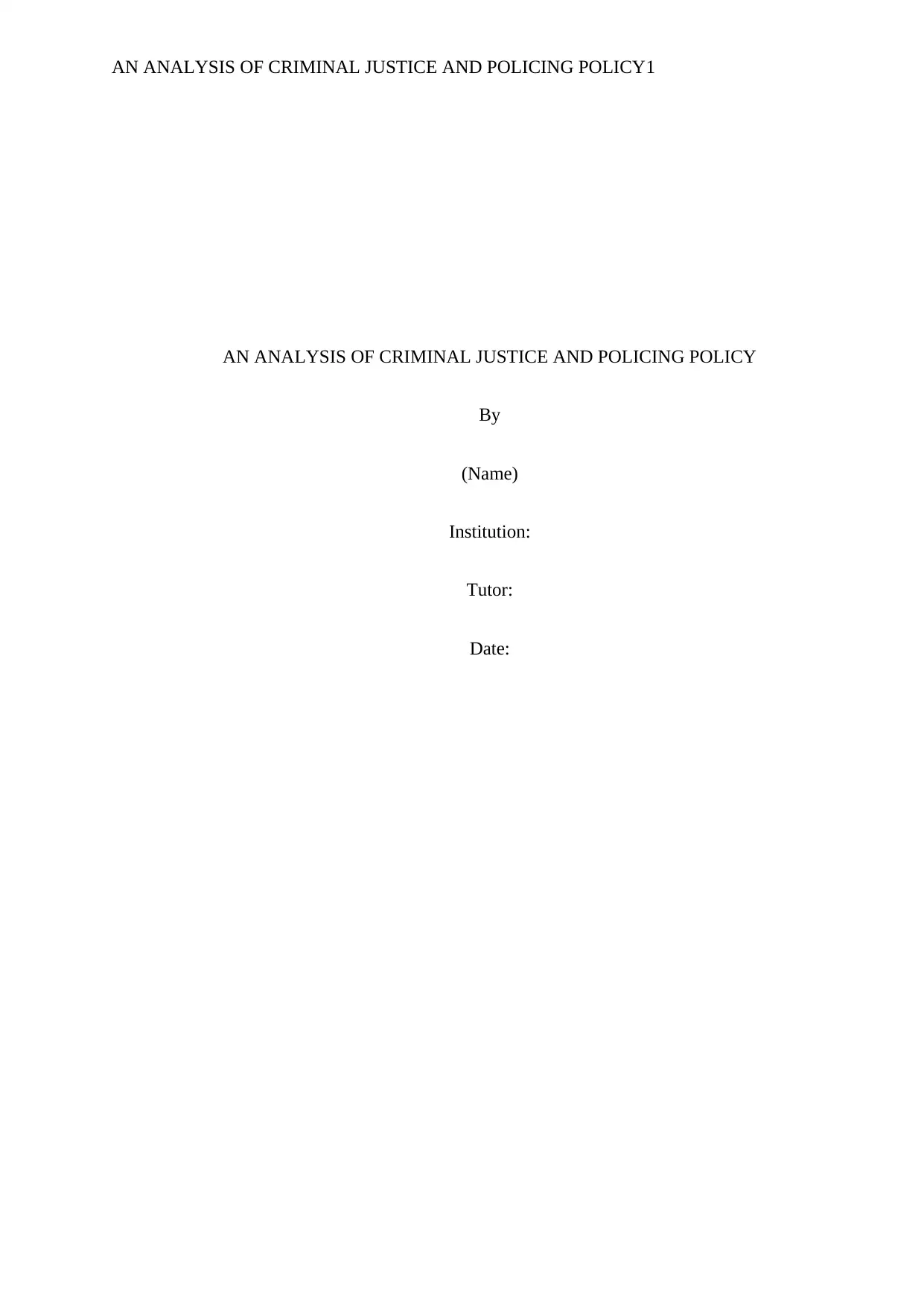
AN ANALYSIS OF CRIMINAL JUSTICE AND POLICING POLICY1
AN ANALYSIS OF CRIMINAL JUSTICE AND POLICING POLICY
By
(Name)
Institution:
Tutor:
Date:
AN ANALYSIS OF CRIMINAL JUSTICE AND POLICING POLICY
By
(Name)
Institution:
Tutor:
Date:
Paraphrase This Document
Need a fresh take? Get an instant paraphrase of this document with our AI Paraphraser
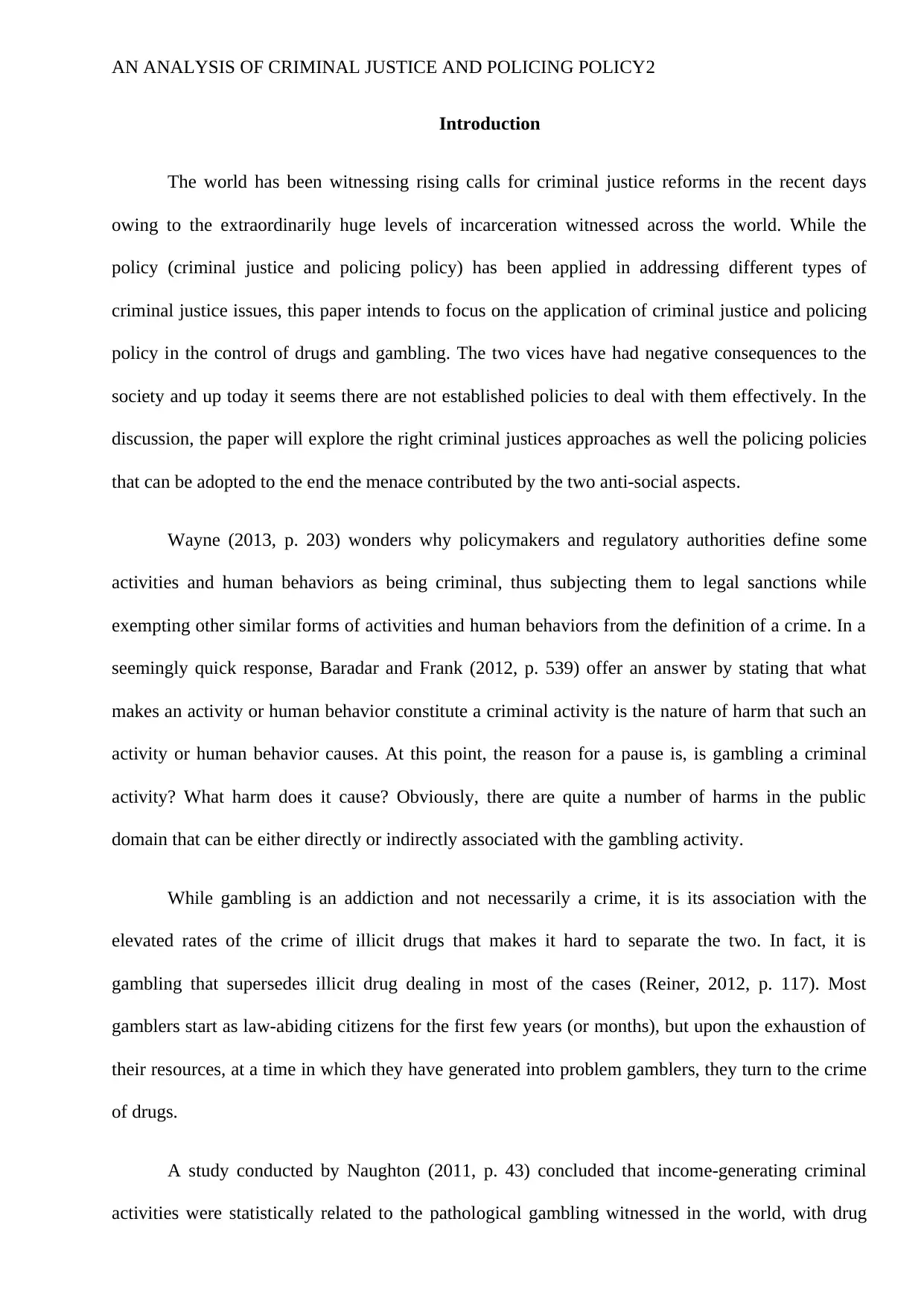
AN ANALYSIS OF CRIMINAL JUSTICE AND POLICING POLICY2
Introduction
The world has been witnessing rising calls for criminal justice reforms in the recent days
owing to the extraordinarily huge levels of incarceration witnessed across the world. While the
policy (criminal justice and policing policy) has been applied in addressing different types of
criminal justice issues, this paper intends to focus on the application of criminal justice and policing
policy in the control of drugs and gambling. The two vices have had negative consequences to the
society and up today it seems there are not established policies to deal with them effectively. In the
discussion, the paper will explore the right criminal justices approaches as well the policing policies
that can be adopted to the end the menace contributed by the two anti-social aspects.
Wayne (2013, p. 203) wonders why policymakers and regulatory authorities define some
activities and human behaviors as being criminal, thus subjecting them to legal sanctions while
exempting other similar forms of activities and human behaviors from the definition of a crime. In a
seemingly quick response, Baradar and Frank (2012, p. 539) offer an answer by stating that what
makes an activity or human behavior constitute a criminal activity is the nature of harm that such an
activity or human behavior causes. At this point, the reason for a pause is, is gambling a criminal
activity? What harm does it cause? Obviously, there are quite a number of harms in the public
domain that can be either directly or indirectly associated with the gambling activity.
While gambling is an addiction and not necessarily a crime, it is its association with the
elevated rates of the crime of illicit drugs that makes it hard to separate the two. In fact, it is
gambling that supersedes illicit drug dealing in most of the cases (Reiner, 2012, p. 117). Most
gamblers start as law-abiding citizens for the first few years (or months), but upon the exhaustion of
their resources, at a time in which they have generated into problem gamblers, they turn to the crime
of drugs.
A study conducted by Naughton (2011, p. 43) concluded that income-generating criminal
activities were statistically related to the pathological gambling witnessed in the world, with drug
Introduction
The world has been witnessing rising calls for criminal justice reforms in the recent days
owing to the extraordinarily huge levels of incarceration witnessed across the world. While the
policy (criminal justice and policing policy) has been applied in addressing different types of
criminal justice issues, this paper intends to focus on the application of criminal justice and policing
policy in the control of drugs and gambling. The two vices have had negative consequences to the
society and up today it seems there are not established policies to deal with them effectively. In the
discussion, the paper will explore the right criminal justices approaches as well the policing policies
that can be adopted to the end the menace contributed by the two anti-social aspects.
Wayne (2013, p. 203) wonders why policymakers and regulatory authorities define some
activities and human behaviors as being criminal, thus subjecting them to legal sanctions while
exempting other similar forms of activities and human behaviors from the definition of a crime. In a
seemingly quick response, Baradar and Frank (2012, p. 539) offer an answer by stating that what
makes an activity or human behavior constitute a criminal activity is the nature of harm that such an
activity or human behavior causes. At this point, the reason for a pause is, is gambling a criminal
activity? What harm does it cause? Obviously, there are quite a number of harms in the public
domain that can be either directly or indirectly associated with the gambling activity.
While gambling is an addiction and not necessarily a crime, it is its association with the
elevated rates of the crime of illicit drugs that makes it hard to separate the two. In fact, it is
gambling that supersedes illicit drug dealing in most of the cases (Reiner, 2012, p. 117). Most
gamblers start as law-abiding citizens for the first few years (or months), but upon the exhaustion of
their resources, at a time in which they have generated into problem gamblers, they turn to the crime
of drugs.
A study conducted by Naughton (2011, p. 43) concluded that income-generating criminal
activities were statistically related to the pathological gambling witnessed in the world, with drug
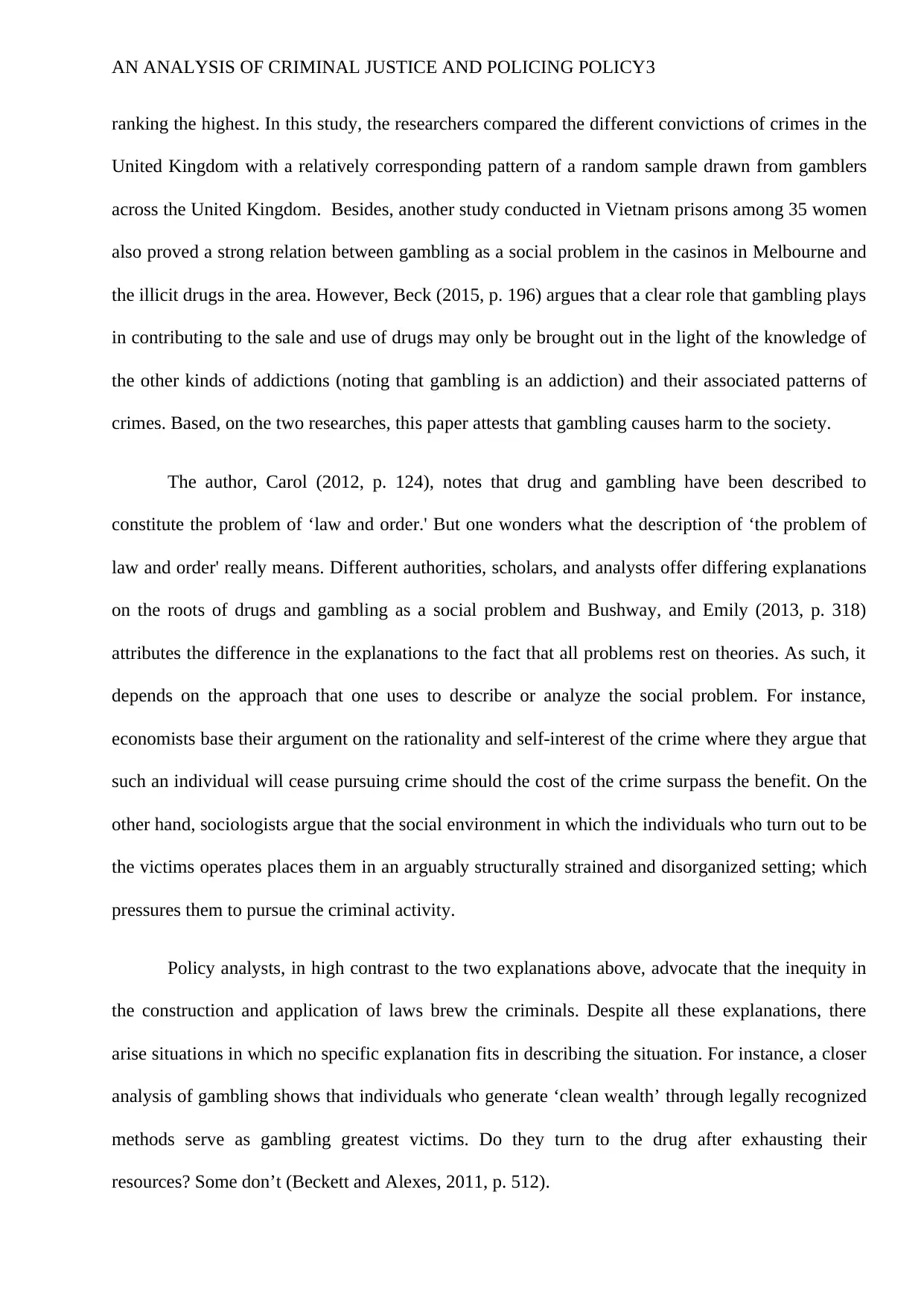
AN ANALYSIS OF CRIMINAL JUSTICE AND POLICING POLICY3
ranking the highest. In this study, the researchers compared the different convictions of crimes in the
United Kingdom with a relatively corresponding pattern of a random sample drawn from gamblers
across the United Kingdom. Besides, another study conducted in Vietnam prisons among 35 women
also proved a strong relation between gambling as a social problem in the casinos in Melbourne and
the illicit drugs in the area. However, Beck (2015, p. 196) argues that a clear role that gambling plays
in contributing to the sale and use of drugs may only be brought out in the light of the knowledge of
the other kinds of addictions (noting that gambling is an addiction) and their associated patterns of
crimes. Based, on the two researches, this paper attests that gambling causes harm to the society.
The author, Carol (2012, p. 124), notes that drug and gambling have been described to
constitute the problem of ‘law and order.' But one wonders what the description of ‘the problem of
law and order' really means. Different authorities, scholars, and analysts offer differing explanations
on the roots of drugs and gambling as a social problem and Bushway, and Emily (2013, p. 318)
attributes the difference in the explanations to the fact that all problems rest on theories. As such, it
depends on the approach that one uses to describe or analyze the social problem. For instance,
economists base their argument on the rationality and self-interest of the crime where they argue that
such an individual will cease pursuing crime should the cost of the crime surpass the benefit. On the
other hand, sociologists argue that the social environment in which the individuals who turn out to be
the victims operates places them in an arguably structurally strained and disorganized setting; which
pressures them to pursue the criminal activity.
Policy analysts, in high contrast to the two explanations above, advocate that the inequity in
the construction and application of laws brew the criminals. Despite all these explanations, there
arise situations in which no specific explanation fits in describing the situation. For instance, a closer
analysis of gambling shows that individuals who generate ‘clean wealth’ through legally recognized
methods serve as gambling greatest victims. Do they turn to the drug after exhausting their
resources? Some don’t (Beckett and Alexes, 2011, p. 512).
ranking the highest. In this study, the researchers compared the different convictions of crimes in the
United Kingdom with a relatively corresponding pattern of a random sample drawn from gamblers
across the United Kingdom. Besides, another study conducted in Vietnam prisons among 35 women
also proved a strong relation between gambling as a social problem in the casinos in Melbourne and
the illicit drugs in the area. However, Beck (2015, p. 196) argues that a clear role that gambling plays
in contributing to the sale and use of drugs may only be brought out in the light of the knowledge of
the other kinds of addictions (noting that gambling is an addiction) and their associated patterns of
crimes. Based, on the two researches, this paper attests that gambling causes harm to the society.
The author, Carol (2012, p. 124), notes that drug and gambling have been described to
constitute the problem of ‘law and order.' But one wonders what the description of ‘the problem of
law and order' really means. Different authorities, scholars, and analysts offer differing explanations
on the roots of drugs and gambling as a social problem and Bushway, and Emily (2013, p. 318)
attributes the difference in the explanations to the fact that all problems rest on theories. As such, it
depends on the approach that one uses to describe or analyze the social problem. For instance,
economists base their argument on the rationality and self-interest of the crime where they argue that
such an individual will cease pursuing crime should the cost of the crime surpass the benefit. On the
other hand, sociologists argue that the social environment in which the individuals who turn out to be
the victims operates places them in an arguably structurally strained and disorganized setting; which
pressures them to pursue the criminal activity.
Policy analysts, in high contrast to the two explanations above, advocate that the inequity in
the construction and application of laws brew the criminals. Despite all these explanations, there
arise situations in which no specific explanation fits in describing the situation. For instance, a closer
analysis of gambling shows that individuals who generate ‘clean wealth’ through legally recognized
methods serve as gambling greatest victims. Do they turn to the drug after exhausting their
resources? Some don’t (Beckett and Alexes, 2011, p. 512).
⊘ This is a preview!⊘
Do you want full access?
Subscribe today to unlock all pages.

Trusted by 1+ million students worldwide
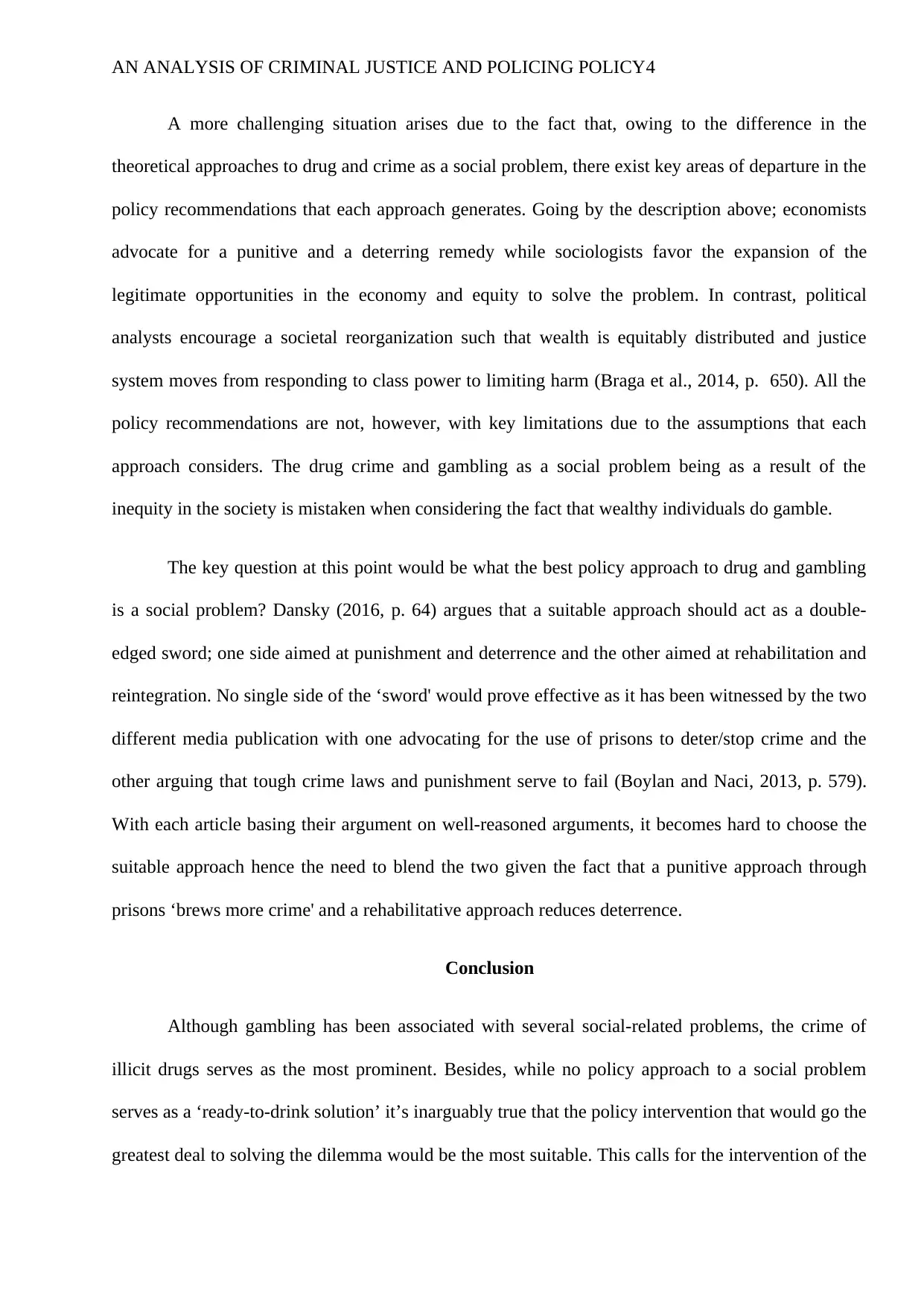
AN ANALYSIS OF CRIMINAL JUSTICE AND POLICING POLICY4
A more challenging situation arises due to the fact that, owing to the difference in the
theoretical approaches to drug and crime as a social problem, there exist key areas of departure in the
policy recommendations that each approach generates. Going by the description above; economists
advocate for a punitive and a deterring remedy while sociologists favor the expansion of the
legitimate opportunities in the economy and equity to solve the problem. In contrast, political
analysts encourage a societal reorganization such that wealth is equitably distributed and justice
system moves from responding to class power to limiting harm (Braga et al., 2014, p. 650). All the
policy recommendations are not, however, with key limitations due to the assumptions that each
approach considers. The drug crime and gambling as a social problem being as a result of the
inequity in the society is mistaken when considering the fact that wealthy individuals do gamble.
The key question at this point would be what the best policy approach to drug and gambling
is a social problem? Dansky (2016, p. 64) argues that a suitable approach should act as a double-
edged sword; one side aimed at punishment and deterrence and the other aimed at rehabilitation and
reintegration. No single side of the ‘sword' would prove effective as it has been witnessed by the two
different media publication with one advocating for the use of prisons to deter/stop crime and the
other arguing that tough crime laws and punishment serve to fail (Boylan and Naci, 2013, p. 579).
With each article basing their argument on well-reasoned arguments, it becomes hard to choose the
suitable approach hence the need to blend the two given the fact that a punitive approach through
prisons ‘brews more crime' and a rehabilitative approach reduces deterrence.
Conclusion
Although gambling has been associated with several social-related problems, the crime of
illicit drugs serves as the most prominent. Besides, while no policy approach to a social problem
serves as a ‘ready-to-drink solution’ it’s inarguably true that the policy intervention that would go the
greatest deal to solving the dilemma would be the most suitable. This calls for the intervention of the
A more challenging situation arises due to the fact that, owing to the difference in the
theoretical approaches to drug and crime as a social problem, there exist key areas of departure in the
policy recommendations that each approach generates. Going by the description above; economists
advocate for a punitive and a deterring remedy while sociologists favor the expansion of the
legitimate opportunities in the economy and equity to solve the problem. In contrast, political
analysts encourage a societal reorganization such that wealth is equitably distributed and justice
system moves from responding to class power to limiting harm (Braga et al., 2014, p. 650). All the
policy recommendations are not, however, with key limitations due to the assumptions that each
approach considers. The drug crime and gambling as a social problem being as a result of the
inequity in the society is mistaken when considering the fact that wealthy individuals do gamble.
The key question at this point would be what the best policy approach to drug and gambling
is a social problem? Dansky (2016, p. 64) argues that a suitable approach should act as a double-
edged sword; one side aimed at punishment and deterrence and the other aimed at rehabilitation and
reintegration. No single side of the ‘sword' would prove effective as it has been witnessed by the two
different media publication with one advocating for the use of prisons to deter/stop crime and the
other arguing that tough crime laws and punishment serve to fail (Boylan and Naci, 2013, p. 579).
With each article basing their argument on well-reasoned arguments, it becomes hard to choose the
suitable approach hence the need to blend the two given the fact that a punitive approach through
prisons ‘brews more crime' and a rehabilitative approach reduces deterrence.
Conclusion
Although gambling has been associated with several social-related problems, the crime of
illicit drugs serves as the most prominent. Besides, while no policy approach to a social problem
serves as a ‘ready-to-drink solution’ it’s inarguably true that the policy intervention that would go the
greatest deal to solving the dilemma would be the most suitable. This calls for the intervention of the
Paraphrase This Document
Need a fresh take? Get an instant paraphrase of this document with our AI Paraphraser
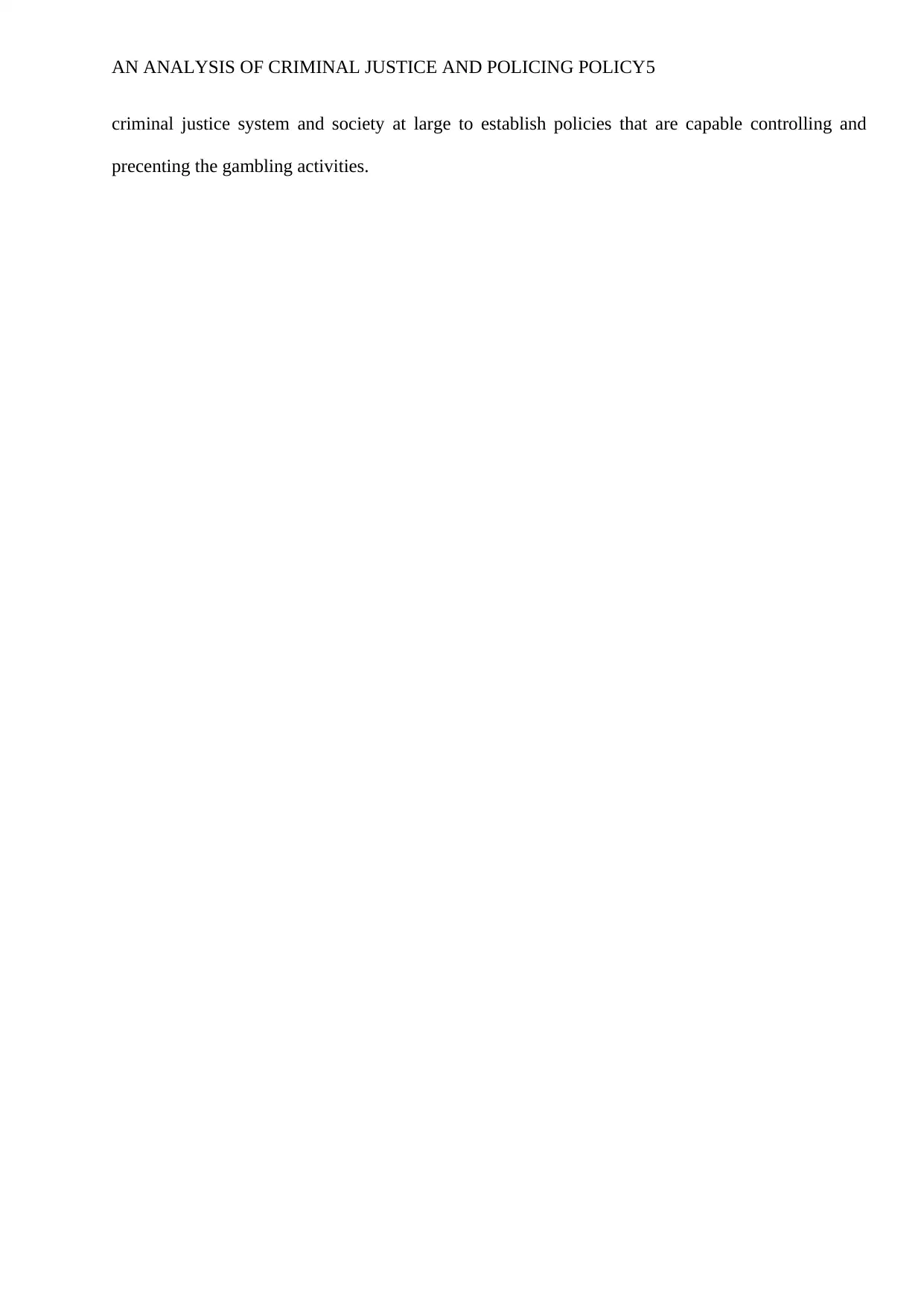
AN ANALYSIS OF CRIMINAL JUSTICE AND POLICING POLICY5
criminal justice system and society at large to establish policies that are capable controlling and
precenting the gambling activities.
criminal justice system and society at large to establish policies that are capable controlling and
precenting the gambling activities.
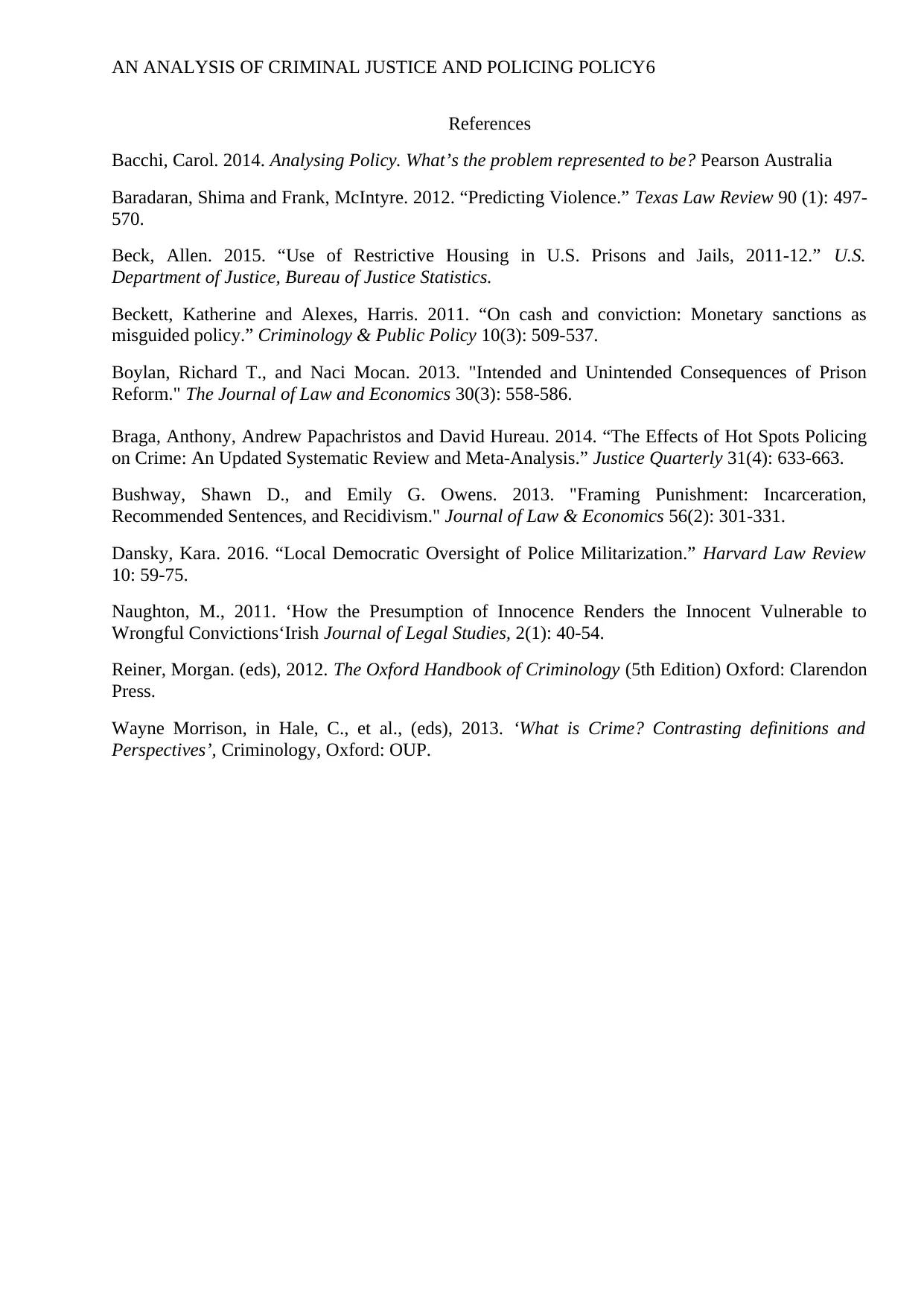
AN ANALYSIS OF CRIMINAL JUSTICE AND POLICING POLICY6
References
Bacchi, Carol. 2014. Analysing Policy. What’s the problem represented to be? Pearson Australia
Baradaran, Shima and Frank, McIntyre. 2012. “Predicting Violence.” Texas Law Review 90 (1): 497-
570.
Beck, Allen. 2015. “Use of Restrictive Housing in U.S. Prisons and Jails, 2011-12.” U.S.
Department of Justice, Bureau of Justice Statistics.
Beckett, Katherine and Alexes, Harris. 2011. “On cash and conviction: Monetary sanctions as
misguided policy.” Criminology & Public Policy 10(3): 509-537.
Boylan, Richard T., and Naci Mocan. 2013. "Intended and Unintended Consequences of Prison
Reform." The Journal of Law and Economics 30(3): 558-586.
Braga, Anthony, Andrew Papachristos and David Hureau. 2014. “The Effects of Hot Spots Policing
on Crime: An Updated Systematic Review and Meta-Analysis.” Justice Quarterly 31(4): 633-663.
Bushway, Shawn D., and Emily G. Owens. 2013. "Framing Punishment: Incarceration,
Recommended Sentences, and Recidivism." Journal of Law & Economics 56(2): 301-331.
Dansky, Kara. 2016. “Local Democratic Oversight of Police Militarization.” Harvard Law Review
10: 59-75.
Naughton, M., 2011. ‘How the Presumption of Innocence Renders the Innocent Vulnerable to
Wrongful Convictions‘Irish Journal of Legal Studies, 2(1): 40-54.
Reiner, Morgan. (eds), 2012. The Oxford Handbook of Criminology (5th Edition) Oxford: Clarendon
Press.
Wayne Morrison, in Hale, C., et al., (eds), 2013. ‘What is Crime? Contrasting definitions and
Perspectives’, Criminology, Oxford: OUP.
References
Bacchi, Carol. 2014. Analysing Policy. What’s the problem represented to be? Pearson Australia
Baradaran, Shima and Frank, McIntyre. 2012. “Predicting Violence.” Texas Law Review 90 (1): 497-
570.
Beck, Allen. 2015. “Use of Restrictive Housing in U.S. Prisons and Jails, 2011-12.” U.S.
Department of Justice, Bureau of Justice Statistics.
Beckett, Katherine and Alexes, Harris. 2011. “On cash and conviction: Monetary sanctions as
misguided policy.” Criminology & Public Policy 10(3): 509-537.
Boylan, Richard T., and Naci Mocan. 2013. "Intended and Unintended Consequences of Prison
Reform." The Journal of Law and Economics 30(3): 558-586.
Braga, Anthony, Andrew Papachristos and David Hureau. 2014. “The Effects of Hot Spots Policing
on Crime: An Updated Systematic Review and Meta-Analysis.” Justice Quarterly 31(4): 633-663.
Bushway, Shawn D., and Emily G. Owens. 2013. "Framing Punishment: Incarceration,
Recommended Sentences, and Recidivism." Journal of Law & Economics 56(2): 301-331.
Dansky, Kara. 2016. “Local Democratic Oversight of Police Militarization.” Harvard Law Review
10: 59-75.
Naughton, M., 2011. ‘How the Presumption of Innocence Renders the Innocent Vulnerable to
Wrongful Convictions‘Irish Journal of Legal Studies, 2(1): 40-54.
Reiner, Morgan. (eds), 2012. The Oxford Handbook of Criminology (5th Edition) Oxford: Clarendon
Press.
Wayne Morrison, in Hale, C., et al., (eds), 2013. ‘What is Crime? Contrasting definitions and
Perspectives’, Criminology, Oxford: OUP.
⊘ This is a preview!⊘
Do you want full access?
Subscribe today to unlock all pages.

Trusted by 1+ million students worldwide
1 out of 6
Related Documents
Your All-in-One AI-Powered Toolkit for Academic Success.
+13062052269
info@desklib.com
Available 24*7 on WhatsApp / Email
![[object Object]](/_next/static/media/star-bottom.7253800d.svg)
Unlock your academic potential
Copyright © 2020–2025 A2Z Services. All Rights Reserved. Developed and managed by ZUCOL.





